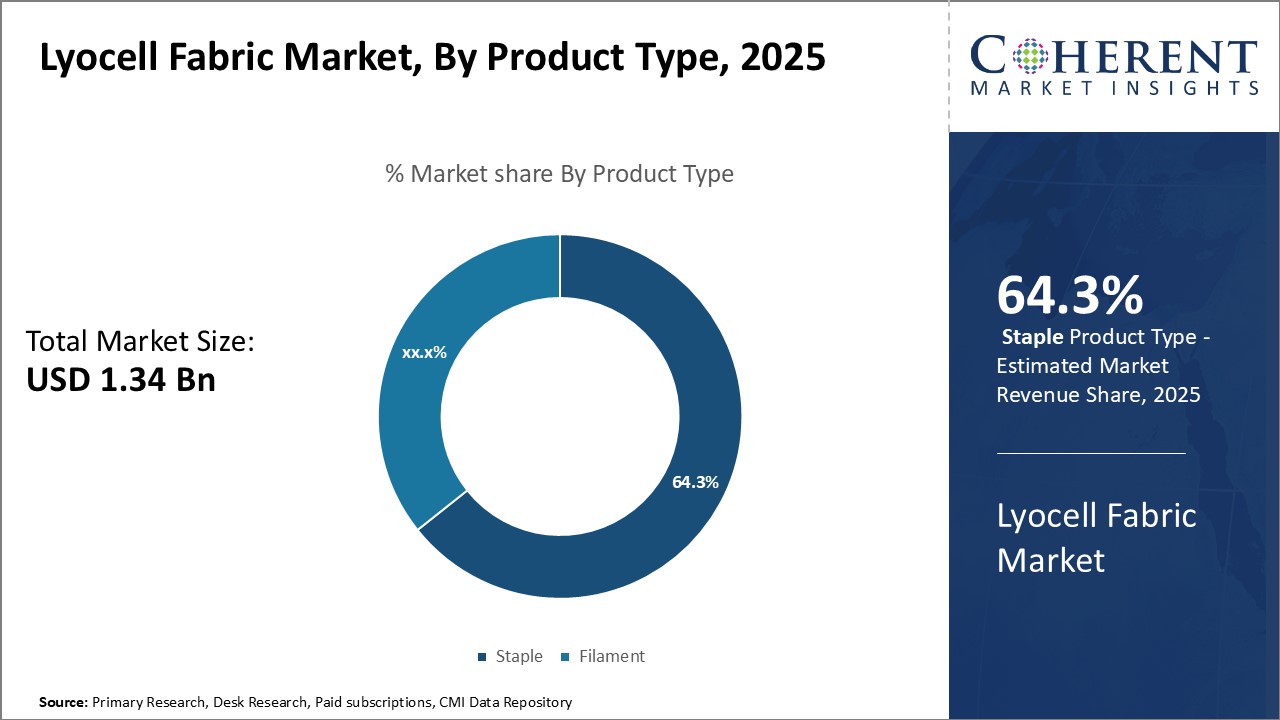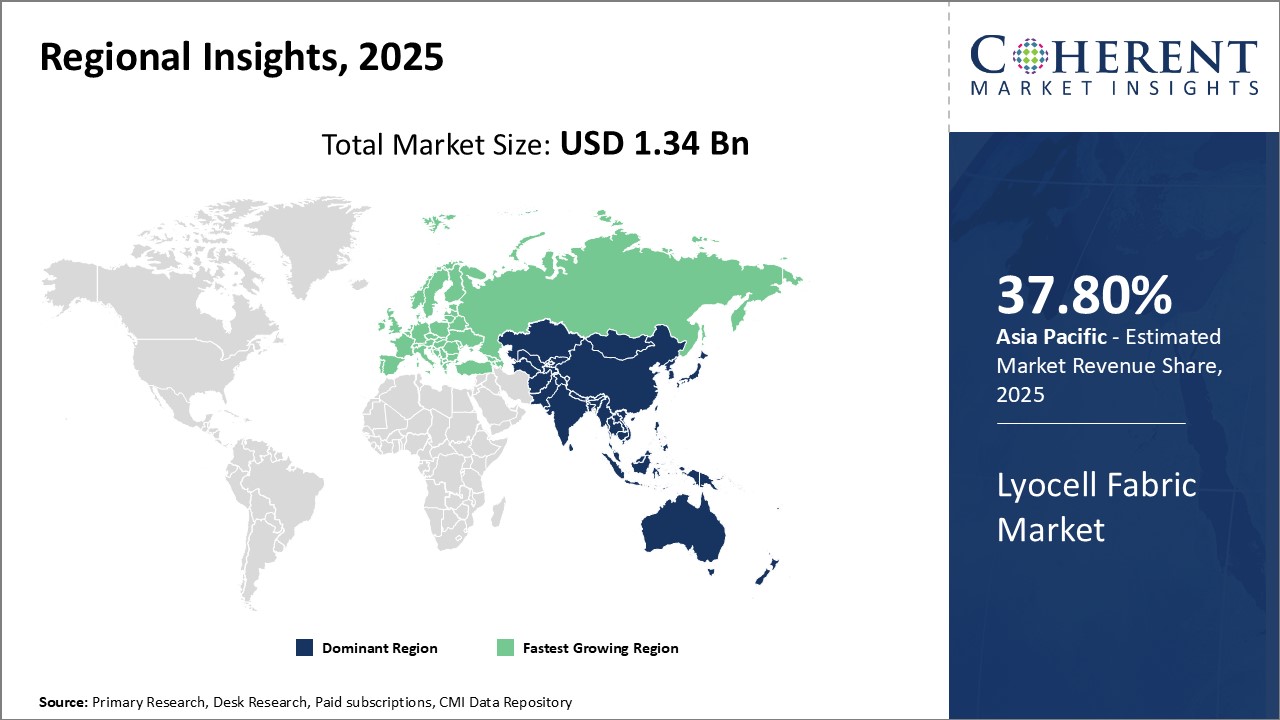Market Size and Trends:
The Lyocell Fabric Market is estimated to be valued at USD 1.34 Bn in 2025 and is expected to reach USD 2.17 Bn by 2032, exhibiting a compound annual growth rate (CAGR) of 7.1% from 2025 to 2032.
Lyocell fibers are created by a solvent spinning technique, and cellulose undergoes no significant chemical change. Lyocell is an extremely sturdy fabric that is used for automotive filters, abrasive materials, ropes, bandages, and protective suiting material. It is primarily found in the garment industry, particularly in women’s clothing.
Figure 1. Global Lyocell Fabric Market Value Share (%), By Product Type, 2025

To learn more about this report, Request sample copy
Drivers:Increasing preference towards use of bio-based resources in various end-use industries such as healthcare and textile is expected to drive demand for lyocell fabric during the forecast period. Lyocell is 100% biodegradable in nature and its production does not produce any harmful by-products. Lyocell is produced from eucalyptus trees, and growth and cultivation of eucalyptus trees requires less water and pesticides, which makes it environment friendly. The amine oxide solvent which is used during production process of lyocell fabric is non-toxic in nature and it is mostly recycled during production. These advantages of lyocell fabric are expected to increase its demand from end-use industries.
Increasing preference for organic clothing among the populace is one of the major factors that is expected to propel growth of market over the forecast period. Lyocell fabric, also known as dissolving pulp, is a type of rayon which contains cellulose and is produced from bleached wood pulp. The fabric was first developed in 1972 by using dry-jet wet spinning process. Lyocell is a breathable, lightweight, wrinkle-resistant, absorbent, and durable fabric. This fabric is capable of imitating a range of textures such as leather, silk, and suede and can also be dyed in various colors. Producers of lyocell fabric are focusing on adopting natural practices for manufacturing lyocell by eliminating, or reducing, the use of chemicals to obtain organic certifications.
In terms of revenue, Asia Pacific is expected to hold a dominant position and account for a market share of around 51.7% in the global lyocell fabric market. Lyocell fabric has application in several end-use industries such as healthcare, hygiene, apparels, home textiles, automotive, etc. Growing textiles market in emerging economies such as India, China, and Thailand among others is expected to drive growth of the global lyocell fabric market over the forecast period. For instance, according to the India Brand Equity Foundation, textile and apparel exports in India valued at US$ 29.8 billion in 2021, and are expected to reach US$ 209.billion in 2021.
Figure 2. Global Lyocell Fabric Market Value Share (%), By Region, 2025

To learn more about this report, Request sample copy
Market Restraints
Lyocell fabric has relatively low surface energy, which makes it difficult for dyes to bind to it. Moreover, dyes required for binding in lyocell fabric are relatively more expensive, which has led to a shift in consumer preference towards substitutes such as synthetic fabric, natural fabric, and cellulose fabric. These factors are expected to hamper growth of the lyocell fabric market over the forecast period.
Lyocell Fabric Market Report Coverage
| Report Coverage | Details | ||
|---|---|---|---|
| Base Year: | 2024 | Market Size in 2025: | USD 1.34 Bn |
| Historical Data for: | 2020 To 2024 | Forecast Period: | 2025 To 2032 |
| Forecast Period 2025 to 2032 CAGR: | 7.1% | 2032 Value Projection: | USD 2.17 Bn |
| Geographies covered: |
|
||
| Segments covered: |
|
||
| Companies covered: |
Lenzing A.G., Aditya Birla Group, AkzoNobel N.V., Smartfiber AG, Nien Foun Fiber Co., Ltd., Invista , Baoding Swan Fiber Co. Ltd., Qingdao Textiles Group Fiber Technology Co., Ltd., China Bambro Textile (Group) Co., Ltd., Acegreen Eco-Material Technology Co. Ltd., China Populus Textile Ltd., and Acelon Chemicals & Fiber Corp. |
||
| Growth Drivers: |
|
||
| Restraints & Challenges: |
|
||
Uncover macros and micros vetted on 75+ parameters: Get instant access to report
Market Trends
Rising access to the internet in emerging & underdeveloped countries, emerging middle class population with disposable incomes, and the expansion of the clothing & footwear industry are main trends in the global Lyocell fabric market. Additionally, discounted rates, combined packages, and variety in product range have influenced consumers to buy products from e-commerce websites, thereby driving market growth.
On the basis of applications, the apparel segment is expected to witness significant market share in the market over the forecast period. Lyocell fabric is soft, lightweight, comfortable, and breathable in nature and has a very smooth surface. Due its high elasticity and strength, it is widely used for producing sportswear. Moreover, lyocell fabric has excellent moisture absorption properties, which makes it a preferred choice for people with sweating problems or those living in rainy weather regions.
Key Developments:
*Definition: Lyocell fabric, also known as Tencel, is a type of cellulose-based textile derived from wood pulp. It falls under the category of regenerated cellulosic fibers and is considered a form of rayon. Lyocell is produced by dissolving wood pulp using a solvent and then extruding the solution through fine holes to create fibers. These fibers are then spun into yarns and woven or knitted into fabric.
Competitive Section
Major players operating in the global lyocell fabric market include Lenzing A.G., Aditya Birla Group, AkzoNobel N.V., Smartfiber AG, Nien Foun Fiber Co., Ltd., Invista , Baoding Swan Fiber Co. Ltd., Qingdao Textiles Group Fiber Technology Co., Ltd., China Bambro Textile (Group) Co., Ltd., Acegreen Eco-Material Technology Co. Ltd., China Populus Textile Ltd., and Acelon Chemicals & Fiber Corp.
Market Segmentation:
Share
Share
Missing comfort of reading report in your local language? Find your preferred language :
Transform your Strategy with Exclusive Trending Reports :
Frequently Asked Questions
Select a License Type
Credibility and Certifications

860519526

9001:2015
27001:2022


Joining thousands of companies around the world committed to making the Excellent Business Solutions.
View All Our Clients
US Reciprocal Tax Impact Analysis On Lyocell Fabric Market
Stay updated on tariff changes with expert insights and timely information